Forecasting Daily Solar Radiation Using CEEMDAN Decomposition-Based MARS Model Trained by Crow Search Algorithm
Abstract
1. Introduction
2. Data Collection
3. Methodology of CEEMDAN and Data-Driven Models
3.1. Complete Ensemble EMD with Adaptive Noise (CEEMDAN)
3.2. Gene Expression Programing (GEP)
3.3. Multivariate Adaptive Regression Splines (MARS)
3.4. Crow Search Algorithm (CSA)
- Defining the optimization problem with all of its constraints, determining the decision variables and setting the CSA parameters, flock size (N), the flight length (fl), maximizing the iteration number (itermax), and the awareness probability (AP).
- Initializing the position and memory in a d-dimensional search space randomly for crows according to Equations (11) and (12). Each crow can be suitable solution for the problem and d indicates the quantity of the decision variables.
- Evaluating the fitness function for each crow by placing the decision variables into the objective function.
- Generating new positions as follows: crow i can generate a new situation and select ones among other cows (crow j) randomly and follows it to discover crow j’s hidden food source.
- The possibility of the new positions for all crows is checked as follows: If new position of crows is possible, the position of that crow is updated. Else, the crow remains in the current situation and new position is not generated for that crow.
- The fitness function for the new position of each crow is evaluated.
- The crows update their memory by Equation (13):where f(.) is an objective function, xi,iter is the position of crow i in iteration, iter and mi,iter are the memory of crow i in iteration iter. The termination criterion is checked (repeat steps 4–7 until itermax). Eventually, the best memory position based on the objective function value is considered as the optimum solution.
3.5. Self-Adaptive Multivariate Adaptive Regression Splines (SaMARS)
4. Model Performance
- Root mean square error (RMSE)
- Relative root mean square error (RRMSE)
- Mean absolute error (MAE)
- Nash-Sutcliffe efficiency (NSE)
- Willmott’s index of agreement (WI)
- Legates-McCabe’s index (LMI)where and are the measured and forecasted DSR values; and indicate the observed and forecasted mean values of DSR; and N is the number of DSR data points. The first criterion, RMSE [Range = (0, +∞); Ideal value = 0] provides the standard deviation of estimating errors; and MAE [Range = (0, +∞); Ideal value = 0] gives an information about the average discrepancies between observed and forecasted values. Both RMSE and MAE criteria are known as the absolute error measures [37]. In addition, RRMSE [Range = (0, +∞); Ideal value = 0] is an adequate criterion when comparing models of different stations. NSE [Range = (−∞, 1); Ideal value = 1] can be applied for evaluating the capability of hydrological approaches. The highest value of NSE indicates a perfect fit between measured and forecasted DSR. A negative value of NSE presents that the proposed model can perform worse than the mean value of time series dataset [56]. Moreover, WI [Range = (0, 1); Ideal value = 1] is a standardized error value of model prediction. Both criteria (e.g., NSE and WI) are sensitive to outliers because of the squaring of difference terms [37,57]. However, LMI [Range = (−∞, 1); Ideal value = 1] is not inflated using the squared values and is not sensitive to outliers [58].
5. Results and Discussion
5.1. Implementation of CEEMDAN Based Models
5.2. Standalone and Hybrid GEP Models
5.3. Standalone and Hybrid MARS Models
5.4. Standalone and Hybrid SaMARS Models
5.5. Comparison of Proposed Hybrid and Standalone Models
6. Conclusions and Future Research
Author Contributions
Funding
Acknowledgments
Conflicts of Interest
References
- Wu, Y.; Wang, J. A novel hybrid model based on artificial neural networks for solar radiation prediction. Renew. Energy 2016, 89, 268–284. [Google Scholar] [CrossRef]
- Demirhan, H.; Atilgan, Y.K. New horizontal global solar radiation estimation models for Turkey based on robust coplot supported genetic programming technique. Energy Convers. Manage. 2015, 106, 1013–1023. [Google Scholar] [CrossRef]
- Despotovic, M.; Nedic, V.; Despotovic, D.; Cvetanovic, S. Evaluation of empirical models for predicting monthly mean horizontal diffuse solar radiation. Renew. Sustain. Energy Rev. 2016, 56, 246–260. [Google Scholar] [CrossRef]
- Mohammadi, K.; Shamshirband, S.; Kamsin, A.; Lai, P.C.; Mansor, Z. Identifying the most significant input parameters for predicting global solar radiation using an ANFIS selection procedure. Renew. Sustain. Energy Rev. 2016, 63, 423–434. [Google Scholar] [CrossRef]
- Gairaa, K.; Khellaf, A.; Messlem, Y.; Chellali, F. Estimation of the daily global solar radiation based on Box–Jenkins and ANN models: A combined approach. Renew. Sustain. Energy Rev. 2016, 57, 238–249. [Google Scholar] [CrossRef]
- Shamshirband, S.; Mohammadi, K.; Chen, H.L.; Samy, G.N.; Petković, D.; Ma, C. Daily global solar radiation prediction from air temperatures using kernel extreme learning machine: A case study for Iran. J. Atmos. Sol.-Terr. Phy. 2015, 134, 109–117. [Google Scholar] [CrossRef]
- Gueymard, C.A. A review of validation methodologies and statistical performance indicators for modeled solar radiation data: Towards a better bankability of solar projects. Renew. Sustain. Energy Rev. 2014, 39, 1024–1034. [Google Scholar] [CrossRef]
- Rehman, S.; Mohandes, M. Artificial neural network estimation of global solar radiation using air temperature and relative humidity. Energy Policy 2008, 36, 571–576. [Google Scholar] [CrossRef]
- Olatomiwa, L.; Mekhilef, S.; Shamshirband, S.; Petković, D. Adaptive neuro-fuzzy approach for solar radiation prediction in Nigeria. Renew. Sustain. Energy Rev. 2015, 51, 1784–1791. [Google Scholar] [CrossRef]
- Zeng, J.; Qiao, W. Short-term solar power prediction using a support vector machine. Renew. Energy 2013, 52, 118–127. [Google Scholar] [CrossRef]
- Wang, L.; Kisi, O.; Zounemat-Kermani, M.; Zhu, Z.; Gong, W.; Niu, Z.; Liu, Z. Prediction of solar radiation in China using different adaptive neuro-fuzzy methods and M5 model tree. Int. J. Climatol. 2017, 37, 1141–1155. [Google Scholar] [CrossRef]
- Kim, S.; Seo, Y.; Rezaie-Balf, M.; Kisi, O.; Ghorbani, M.A.; Singh, V.P. Evaluation of daily solar radiation flux using soft computing approaches based on different meteorological information: peninsula vs continent. Theor. Appl. Climatol. 2018, 1–20. [Google Scholar] [CrossRef]
- Landeras, G.; López, J.J.; Kisi, O.; & Shiri, J. Comparison of Gene Expression Programming with neuro-fuzzy and neural network computing techniques in estimating daily incoming solar radiation in the Basque Country (Northern Spain). Energy Convers. Manag. 2012, 62, 1–13. [Google Scholar] [CrossRef]
- Yadav, A.K.; Chandel, S.S. Solar radiation prediction using Artificial Neural Network techniques: A review. Renew. Sustain. Energy Rev. 2014, 33, 772–781. [Google Scholar] [CrossRef]
- Sozen, A.; Arcakliogblu, E.; Ozalp, M. Estimation of solar potential in Turkey by artificial neural networks using meteorological and geographical data. Energy Convers. Manag. 2004, 45, 3033–3052. [Google Scholar] [CrossRef]
- Dorvlo, A.S.; Jervase, J.A.; Al-Lawati, A. Solar radiation estimation using artificial neural networks. Appl. Energy 2002, 71, 307–319. [Google Scholar] [CrossRef]
- Alsina, E.F.; Bortolini, M.; Gamberi, M.; Regattieri, A. Artificial neural network optimisation for monthly average daily global solar radiation prediction. Energy Convers. Manag. 2016, 120, 320–329. [Google Scholar] [CrossRef]
- Lou, S.; Li, D.H.; Lam, J.C.; Chan, W.H. Prediction of diffuse solar irradiance using machine learning and multivariable regression. Appl. Energy 2016, 181, 367–374. [Google Scholar] [CrossRef]
- Mohammadi, K.; Shamshirband, S.; Tong, C.W.; Arif, M.; Petković, D.; Ch, S. A new hybrid support vector machine–wavelet transform approach for estimation of horizontal global solar radiation. Energy Convers. Manag. 2015, 92, 162–171. [Google Scholar] [CrossRef]
- Antonanzas, J.; Urraca, R.; Martinez-de-Pison, F.J.; Antonanzas-Torres, F. Solar irradiation mapping with exogenous data from support vector regression machines estimations. Energy Convers. Manag. 2015, 100, 380–390. [Google Scholar] [CrossRef]
- Monteiro, R.V.; Guimarães, G.C.; Moura, F.A.; Albertini, M.R.; Albertini, M.K. Estimating photovoltaic power generation: performance analysis of artificial neural networks, Support Vector Machine and Kalman filter. Electr. Power Syst. Res. 2017, 143, 643–656. [Google Scholar] [CrossRef]
- Chen, J.L.; Liu, H.B.; Wu, W.; Xie, D.T. Estimation of monthly solar radiation from measured temperatures using support vector machines – a case study. Renew. Energy 2011, 36, 413–420. [Google Scholar] [CrossRef]
- Salcedo-Sanz, S.; Deo, R.C.; Cornejo-Bueno, L.; Camacho-Gómez, C.; Ghimire, S. An efficient neuro-evolutionary hybrid modelling mechanism for the estimation of daily global solar radiation in the Sunshine State of Australia. Appl. Energy 2018, 209, 79–94. [Google Scholar] [CrossRef]
- Hu, T.; Wu, F.; Zhang, X. Rainfall–runoff modeling using principal component analysis and neural network. Hydrol. Res. 2007, 38, 235–248. [Google Scholar] [CrossRef]
- Ravikumar, P.; Somashekar, R.K. Principal component analysis and hydrochemical facies characterization to evaluate groundwater quality in Varahi river basin, Karnataka state, India. Appl. Water Sci. 2017, 7, 745–755. [Google Scholar] [CrossRef]
- Sang, Y.F.; Wang, Z.; Liu, C. Discrete wavelet-based trend identification in hydrologic time series. Hydrol. Process. 2013, 27, 2021–2031. [Google Scholar] [CrossRef]
- Rezaie-Balf, M.; Naganna, S.R.; Ghaemi, A.; Deka, P.C. Wavelet coupled MARS and M5 Model Tree approaches for groundwater level forecasting. J. Hydrol. 2017, 553, 356–373. [Google Scholar] [CrossRef]
- Deo, R.C.; Wen, X.; Qi, F. A wavelet-coupled support vector machine model for forecasting global incident solar radiation using limited meteorological dataset. Appl. Energy 2016, 168, 568–593. [Google Scholar] [CrossRef]
- Yuan, X.; Tan, Q.; Lei, X.; Yuan, Y.; Wu, X. Wind power prediction using hybrid autoregressive fractionally integrated moving average and least square support vector machine. Energy 2017, 129, 122–137. [Google Scholar] [CrossRef]
- Zakhrouf, M.; Bouchelkia, H.; Stamboul, M.; Kim, S.; Heddam, S. Time series forecasting of river flow using an integrated approach of wavelet multi-resolution analysis and evolutionary data-driven models. A case study: Sebaou River (Algeria). Phys. Geogr. 2018, 39, 506–522. [Google Scholar] [CrossRef]
- Benedetto, F.; Giunta, G.; Mastroeni, L. A maximum entropy method to assess the predictability of financial and commodity prices. Digit. Signal. Process. 2015, 46, 19–31. [Google Scholar] [CrossRef]
- Baykasoğlu, A.; Güllü, H.; Çanakçı, H.; Özbakır, L. Prediction of compressive and tensile strength of limestone via genetic programming. Expert Syst. Appl. 2008, 35, 111–123. [Google Scholar] [CrossRef]
- Liu, H.; Mi, X.; Li, Y. Smart multi-step deep learning model for wind speed forecasting based on variational mode decomposition, singular spectrum analysis, LSTM network and ELM. Energy Convers. Manag. 2018, 159, 54–64. [Google Scholar] [CrossRef]
- Rezaie-Balf, M.; Kisi, O.; Chua, L.H. Application of ensemble empirical mode decomposition based on machine learning methodologies in forecasting monthly pan evaporation. Hydrol. Res. 2018. [Google Scholar] [CrossRef]
- Al-Musaylh, M.S.; Deo, R.C.; Li, Y.; Adamowski, J.F. Two-phase particle swarm optimized-support vector regression hybrid model integrated with improved empirical mode decomposition with adaptive noise for multiple-horizon electricity demand forecasting. Appl. Energy 2018, 217, 422–439. [Google Scholar] [CrossRef]
- Zhang, W.; Qu, Z.; Zhang, K.; Mao, W.; Ma, Y.; Fan, X. A combined model based on CEEMDAN and modified flower pollination algorithm for wind speed forecasting. Energy Convers. Manag. 2017, 136, 439–451. [Google Scholar] [CrossRef]
- Prasad, R.; Deo, R.C.; Li, Y.; Maraseni, T. Ensemble committee-based data intelligent approach for generating soil moisture forecasts with multivariate hydro-meteorological predictors. Soil. Till. Res. 2018, 181, 63–81. [Google Scholar] [CrossRef]
- Wen, X.; Feng, Q.; Deo, R.C.; Wu, M.; Yin, Z.; Yang, L.; Singh, V.P. Two-phase extreme learning machines integrated with complete ensemble empirical mode decomposition with adaptive noise for multi-scale runoff prediction. J. Hydrol. 2019, 570, 167–184. [Google Scholar] [CrossRef]
- Bailek, N.; Bouchouicha, K.; Al-Mostafa, Z.; El-Shimy, M.; Aoun, N.; Slimani, A.; Al-Shehri, S. A new empirical model for forecasting the diffuse solar radiation over Sahara in the Algerian Big South. Renew. Energy 2018, 117, 530–537. [Google Scholar] [CrossRef]
- Wu, Z.; Huang, N.E. Ensemble empirical mode decomposition: A noise-assisted data analysis method. Adv. Adapt. Data Anal. 2009, 1, 1–41. [Google Scholar] [CrossRef]
- Huang, N.E.; Shen, Z.; Long, S.R.; Wu, M.C.; Shih, H.H.; Zheng, Q.; Yen, N.C.; Chi, C.T.; Liu, H.H. The empirical mode decomposition and the hilbert spectrum for nonlinear and non-stationary time series analysis. Proc. Math. Phys. Eng. Sci. 1998, 454, 903–995. [Google Scholar] [CrossRef]
- Lei, Y.; He, Z.; Zi, Y. Application of the EEMD method to rotor fault diagnosis of rotating machinery. Mech. Syst. Signal. Pr. 2009, 23, 1327–1338. [Google Scholar] [CrossRef]
- Torres, M.E.; Colominas, M.A.; Schlotthauer, G.; Flandrin, P. A complete ensemble empirical mode decomposition with adaptive noise. In Proceedings of the 2011 IEEE International Conference on Acoustics, Speech and Signal Processing (ICASSP), Prague, Czech Republic, 22–27 May 2011; pp. 4144–4147. [Google Scholar]
- Ferreira, C. Gene expression programming in problem solving. In Soft Computing and Industry; Springer: London, UK, 2002; pp. 635–653. [Google Scholar]
- Gholampour, A.; Gandomi, A.H.; Ozbakkaloglu, T. New formulations for mechanical properties of recycled aggregate concrete using gene expression programming. Constr. Build. Mat. 2017, 130, 122–145. [Google Scholar] [CrossRef]
- Ferreira, C. Gene expression programming and the evolution of computer programs. In Recent Developments in Biologically Inspired Computing; Idea Group Publishing: Hershey, PA, USA, 2005; pp. 82–103. [Google Scholar]
- Hossein Alavi, A.; Hossein Gandomi, A. A robust data mining approach for formulation of geotechnical engineering systems. Eng. Comput. 2011, 28, 242–274. [Google Scholar] [CrossRef]
- Friedman, J. Multivariate Adaptive Regression Splines. Ann. Stat. 1991, 19, 1–67. [Google Scholar] [CrossRef]
- Kisi, O. Pan evaporation modeling using least square support vector machine, multivariate adaptive regression splines and M5 model tree. J. Hydrol. 2015, 528, 312–320. [Google Scholar] [CrossRef]
- Rezaie-Balf, M. Multivariate Adaptive Regression Splines Model for Prediction of Local Scour Depth Downstream of an Apron Under 2D Horizontal Jets. Iran. J. Sci. Tech. Trans. Civil Eng. 2018, 1–13. [Google Scholar] [CrossRef]
- Zhang, W.G.; Goh, A.T.C. Multivariate adaptive regression splines for analysis of geotechnical engineering systems. Comput. Geotech. 2013, 48, 82–95. [Google Scholar] [CrossRef]
- Conoscenti, C.; Ciaccio, M.; Caraballo-Arias, N.A.; Gómez-Gutiérrez, Á.; Rotigliano, E.; Agnesi, V. Assessment of susceptibility to earth-flow landslide using logistic regression and multivariate adaptive regression splines: A case of the Belice River basin (western Sicily, Italy). Geomorphology 2015, 242, 49–64. [Google Scholar] [CrossRef]
- Zhang, W.; Goh, A.T. Multivariate adaptive regression splines and neural network models for prediction of pile drivability. Geosci. Front. 2016, 7, 45–52. [Google Scholar] [CrossRef]
- Askarzadeh, A. A novel metaheuristic method for solving constrained engineering optimization problems: crow search algorithm. Comput. Struct. 2016, 169, 1–12. [Google Scholar] [CrossRef]
- Gupta, D.; Rodrigues, J.J.; Sundaram, S.; Khanna, A.; Korotaev, V.; de Albuquerque, V.H.C. Usability feature extraction using modified crow search algorithm: A novel approach. Neural Comput. Appl. 2018, 1–11. [Google Scholar] [CrossRef]
- Nash, J.E.; Sutcliffe, J.V. River flow forecasting through conceptual models, Part 1—A discussion of principles. J. Hydrol. 1970, 10, 282–290. [Google Scholar] [CrossRef]
- Willmott, C.J.; Robeson, S.M.; Matsuura, K. A refined index of model performance. Int. J. Climatol. 2012, 32, 2088–2094. [Google Scholar] [CrossRef]
- Legates, D.R.; McCabe, G.J. Evaluating the use of “goodness-of-fit” measures in hydrologic and hydroclimatic model validation. Water Resour. Res. 1999, 35, 233–241. [Google Scholar] [CrossRef]
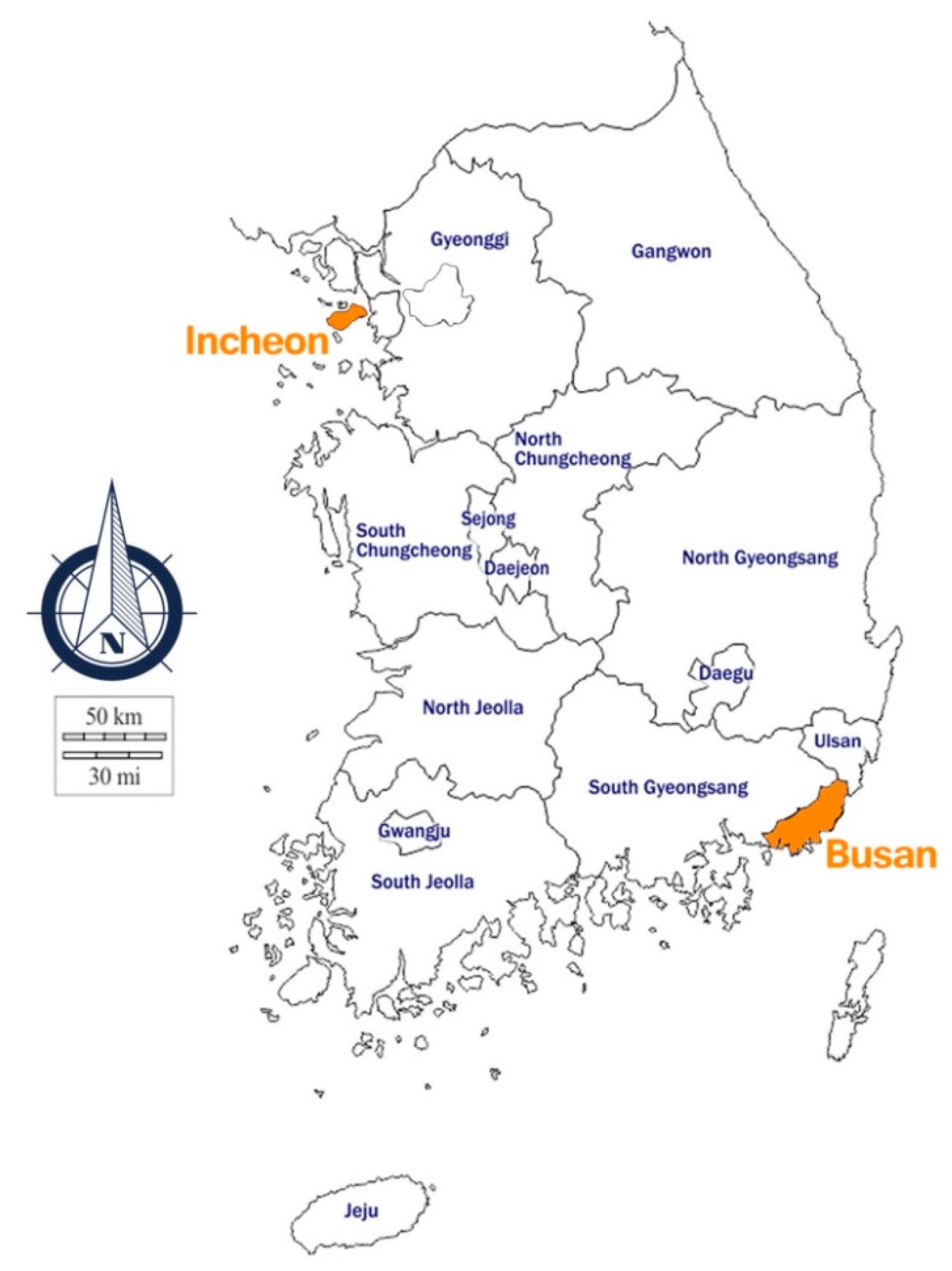
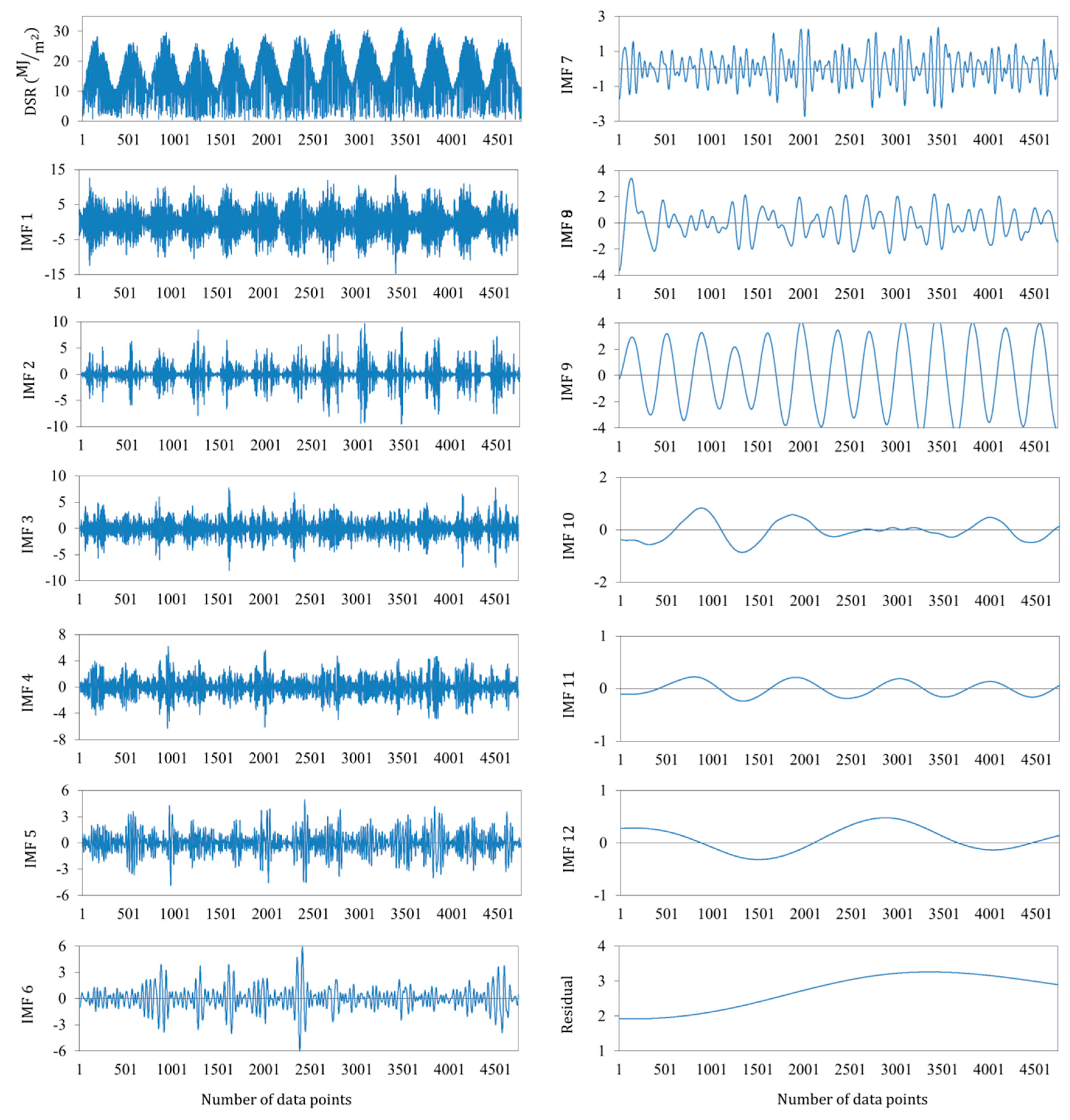
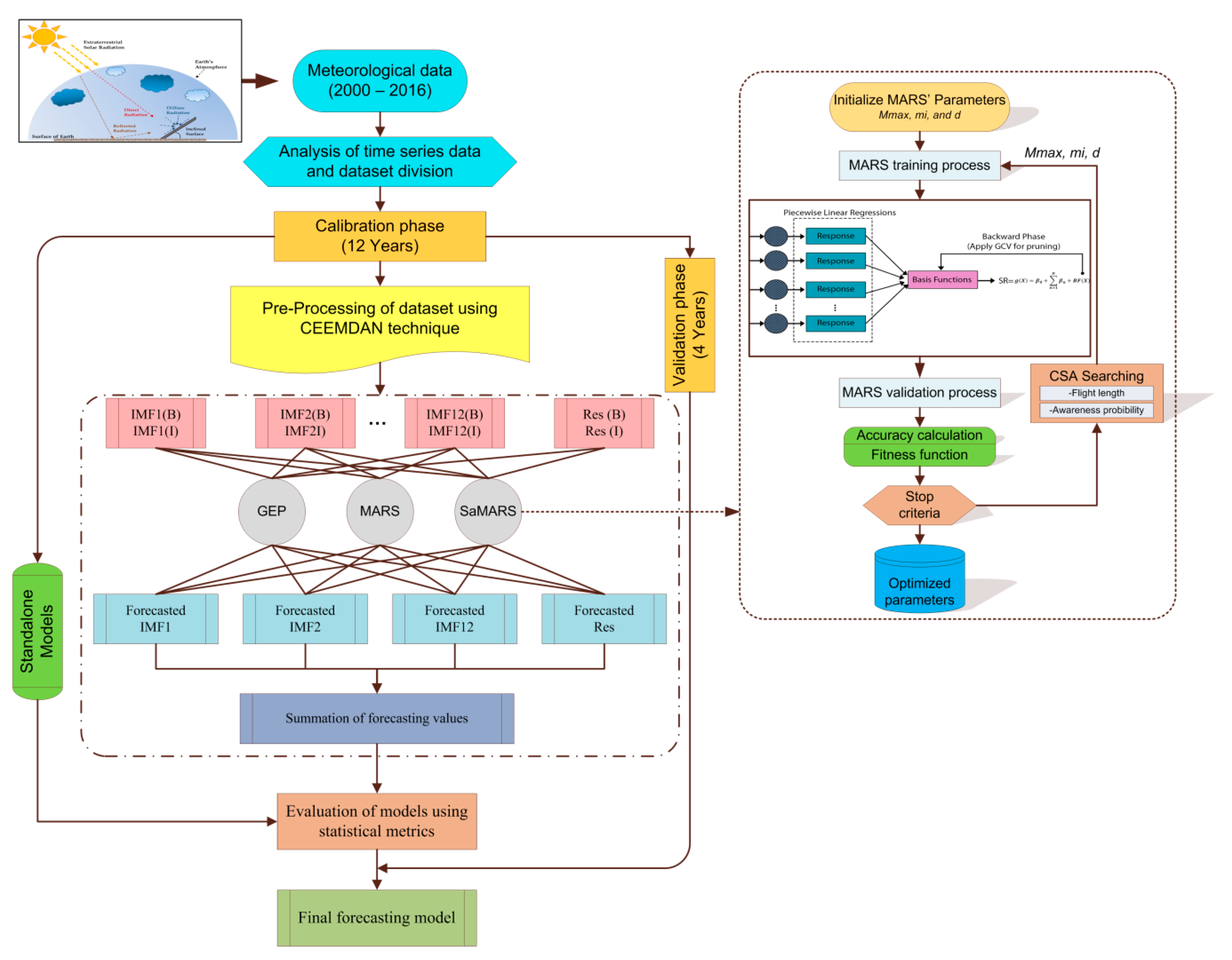
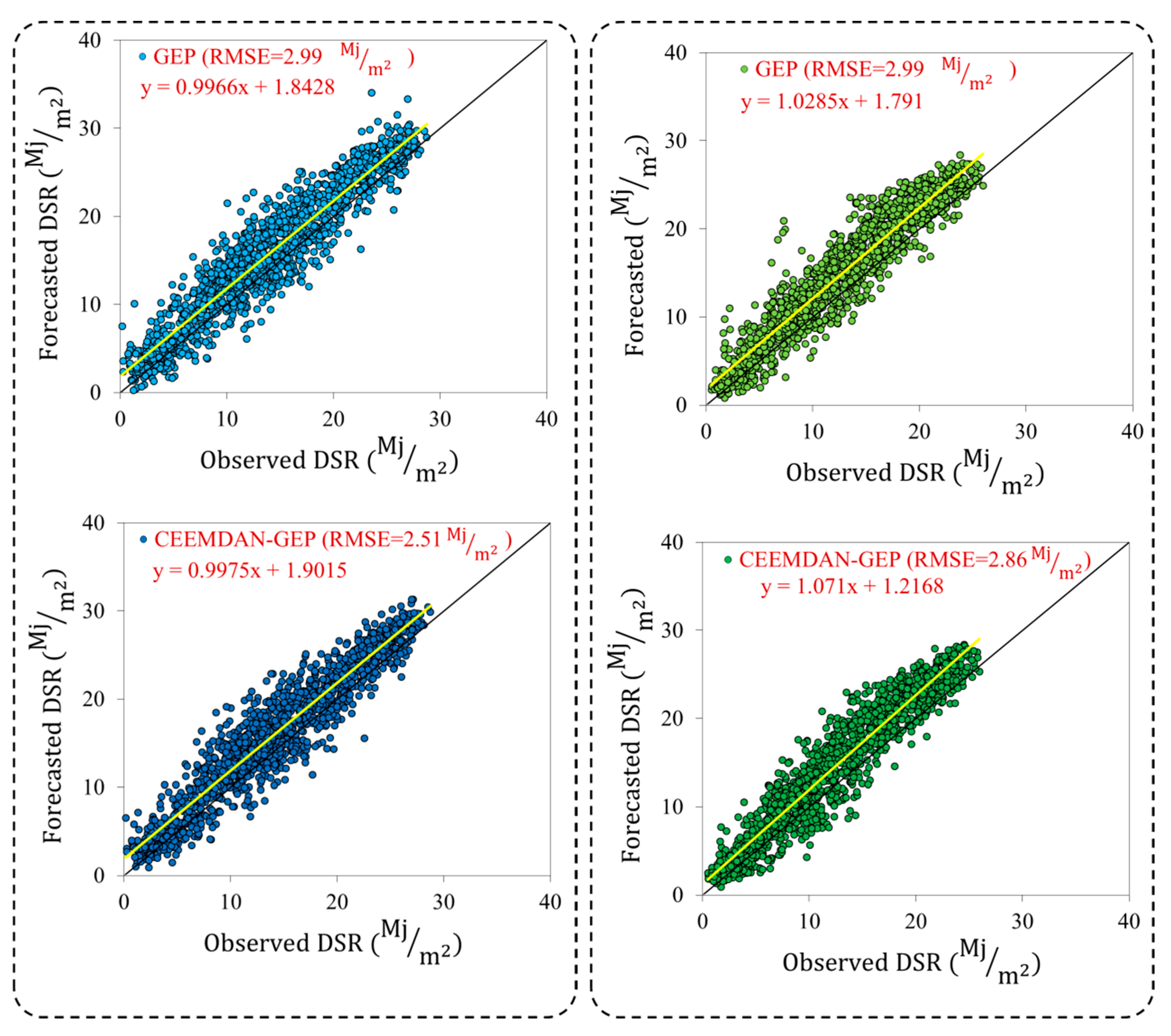
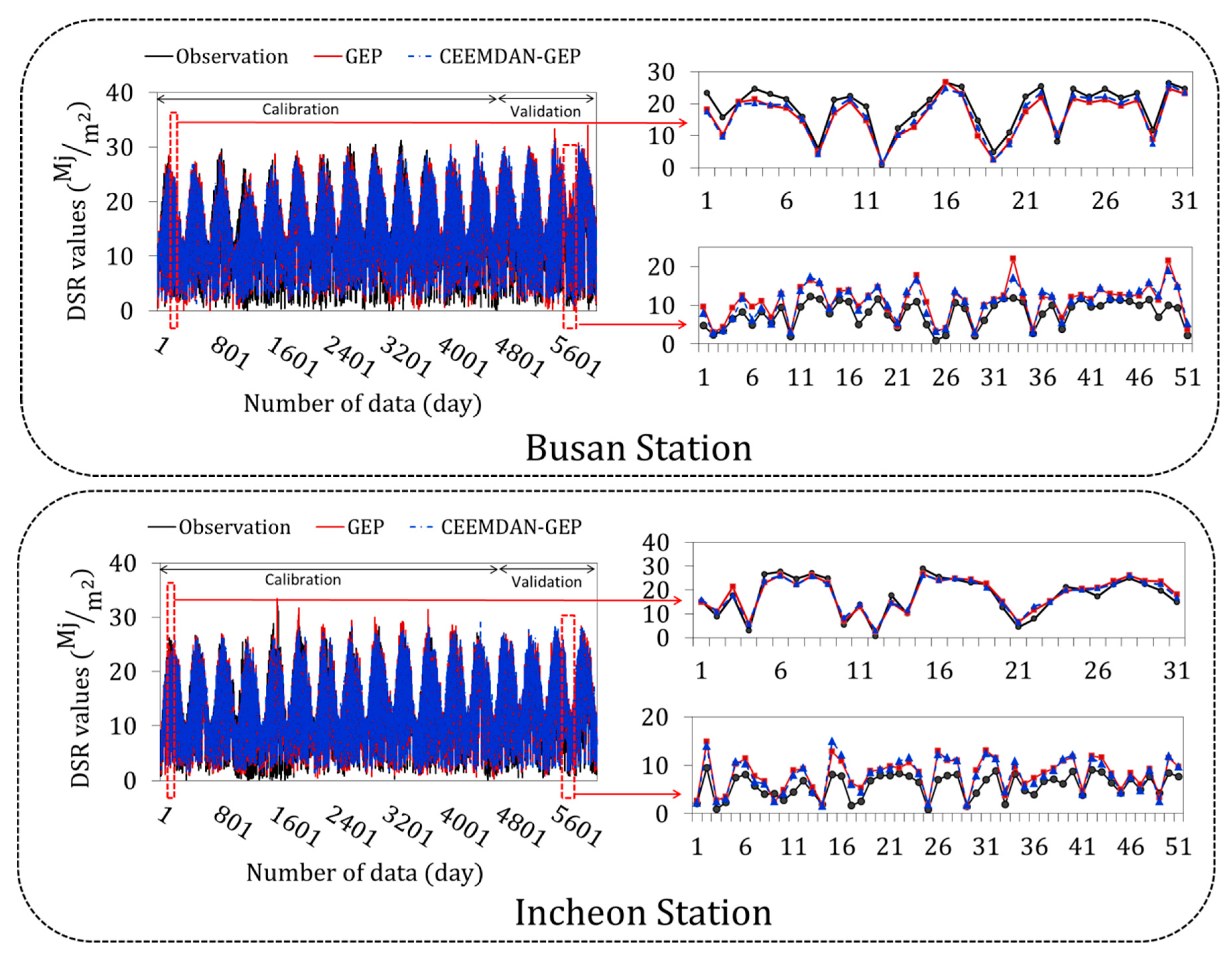
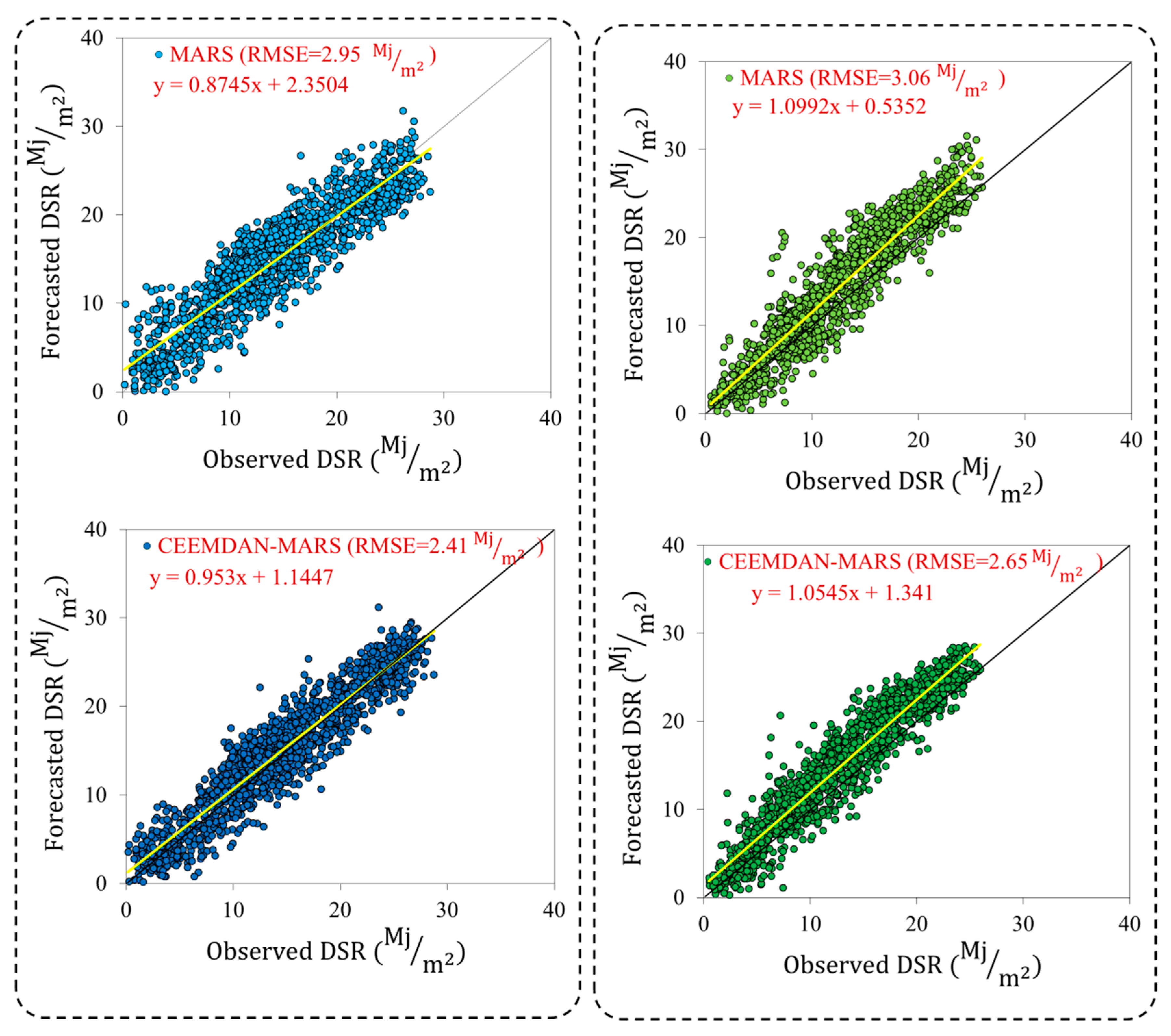
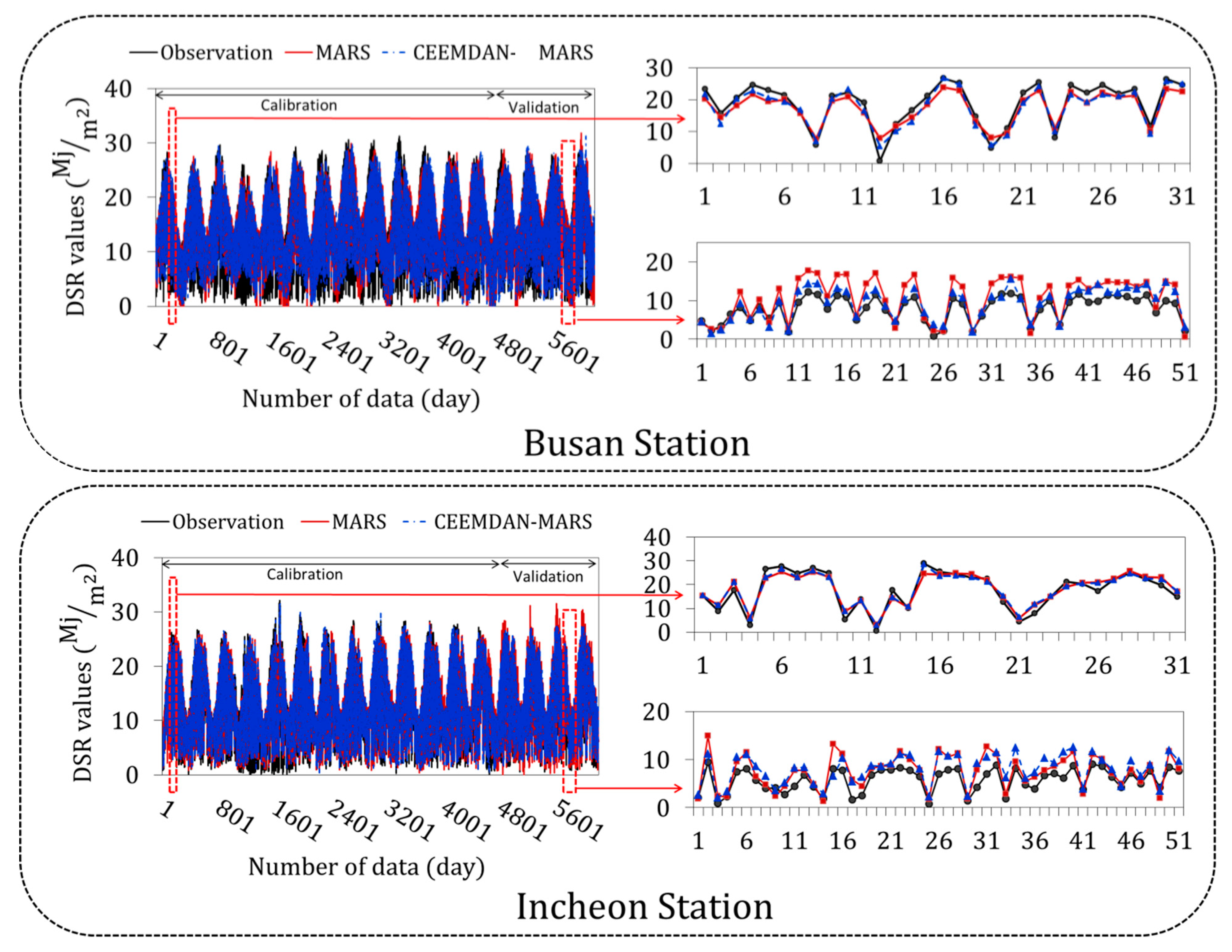
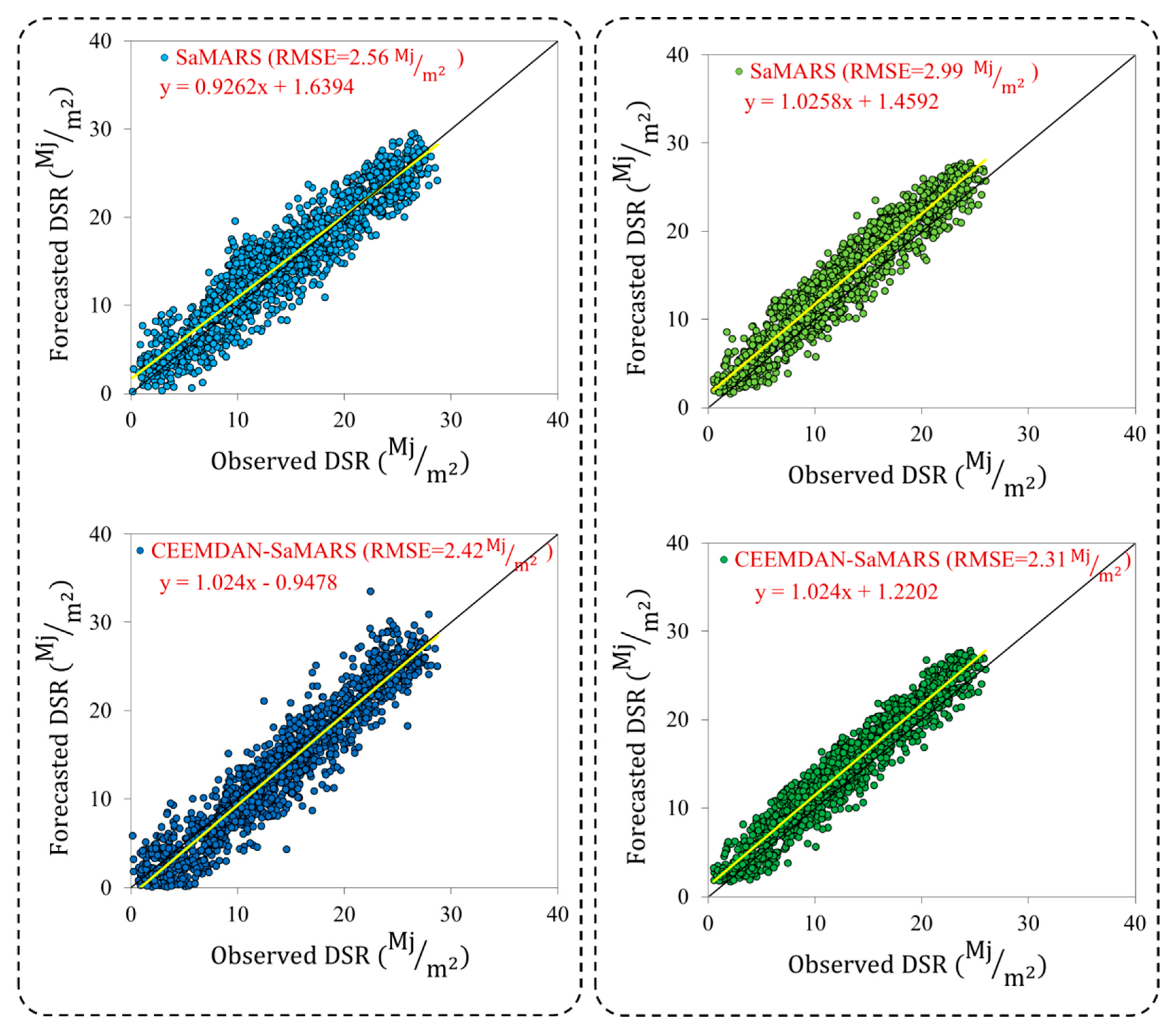

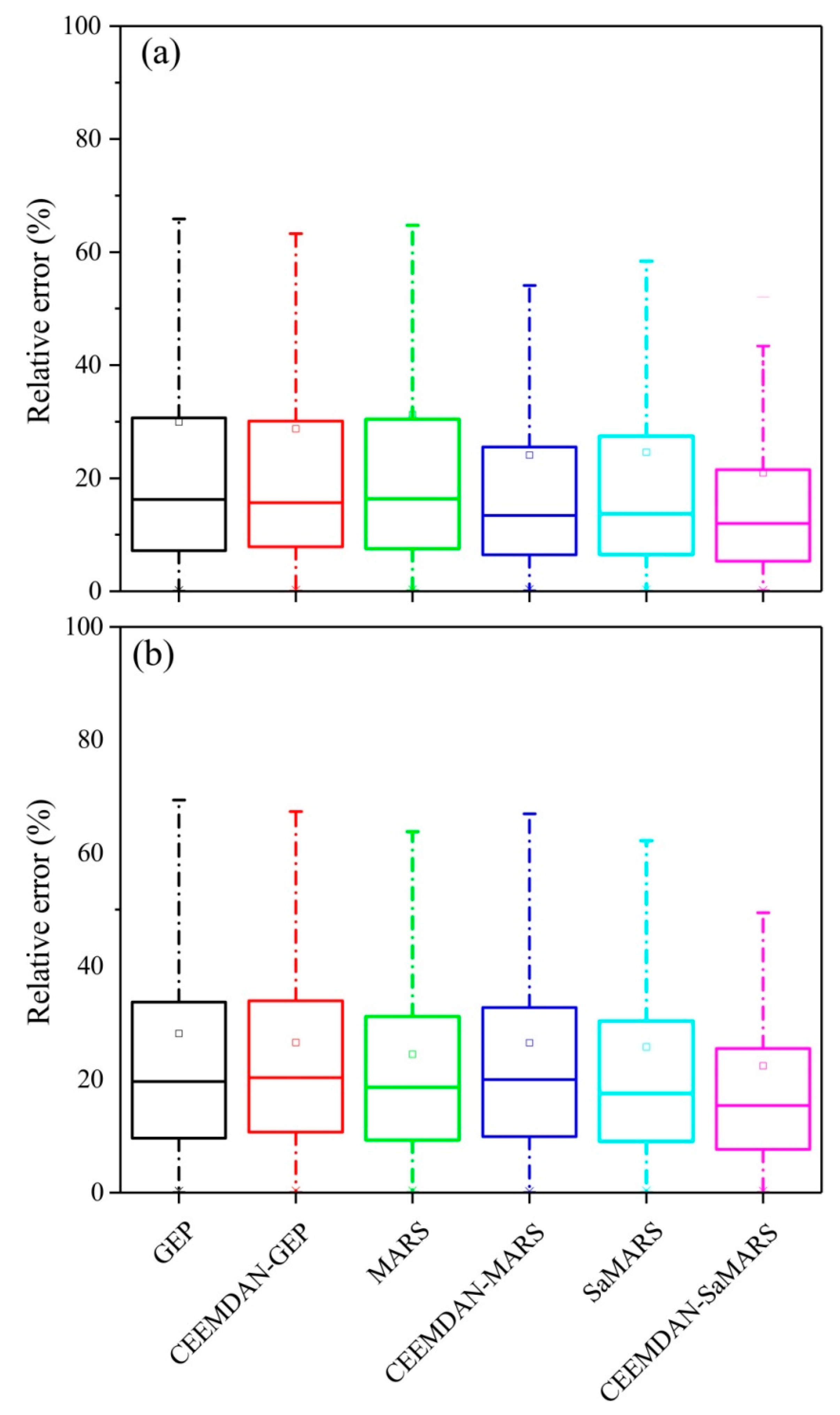
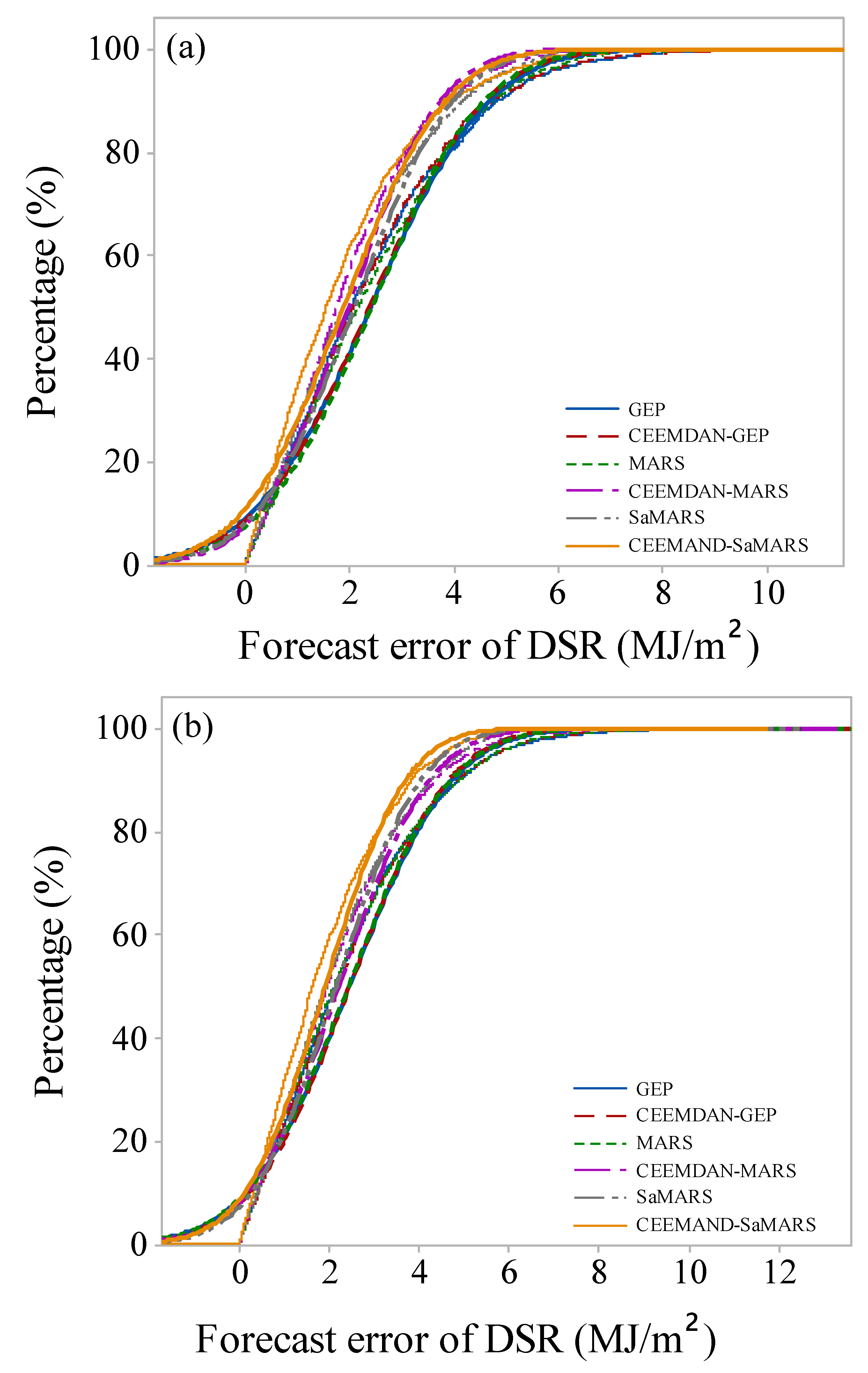
| Statistical Parameter | Meteorological Variable | ||||||
|---|---|---|---|---|---|---|---|
| TA (°C) | RH (%) | VP (hPa) | SLP (hPa) | PE (cm) | SD (hr) | DSR (MJ/m2) | |
| Busan station (calibration data, 2000–2012) | |||||||
| Minimum | −7.2 | 11.3 | 0.8 | 992.2 | 0.2 | 0.0 | 0.0 |
| Mean | 14.8 | 62.2 | 12.9 | 1015.5 | 3.1 | 6.1 | 14.1 |
| Maximum | 30.1 | 99.0 | 37.2 | 1036.2 | 8.8 | 13.1 | 31.3 |
| Standard deviation | 8.2 | 18.8 | 8.4 | 7.1 | 1.5 | 3.9 | 7.0 |
| Coefficient of variation | 66.5 | 354.7 | 70.5 | 51.1 | 2.2 | 14.9 | 49.4 |
| Skewness index | −0.3 | −0.2 | 0.5 | −0.1 | 0.5 | −0.3 | 0.1 |
| Busan station (validation data, 2013–2016) | |||||||
| Minimum | −7.6 | 17.6 | 1.1 | 992.7 | 0.0 | 0.0 | 0.2 |
| Mean | 15.4 | 64.1 | 13.4 | 1015.8 | 3.4 | 7.1 | 14.0 |
| Maximum | 31.7 | 99.9 | 33.1 | 1034.4 | 11.5 | 13.1 | 28.7 |
| Standard deviation | 8.1 | 17.8 | 8.3 | 7.4 | 1.7 | 4.1 | 7.0 |
| Coefficient of variation | 66.0 | 318.6 | 68.6 | 55.3 | 2.9 | 17.0 | 48.3 |
| Skewness index | −0.3 | −0.2 | 0.4 | −0.1 | 0.5 | −0.6 | 0.1 |
| Incheon station (calibration data, 2000–2012) | |||||||
| Minimum | −14.6 | 25.0 | 0.9 | 990.8 | 0.0 | 0.0 | 0.0 |
| Mean | 12.6 | 67.3 | 12.2 | 1016.1 | 3.0 | 6.0 | 12.9 |
| Maximum | 31.1 | 100.0 | 34.1 | 1039.0 | 12.0 | 13.7 | 32.1 |
| Standard deviation | 9.8 | 15.0 | 8.3 | 8.1 | 1.8 | 3.9 | 6.9 |
| Coefficient of variation | 97.0 | 224.8 | 68.3 | 65.4 | 3.3 | 15.5 | 47.1 |
| Skewness index | −0.3 | −0.1 | 0.6 | 0.0 | 0.7 | −0.2 | 0.2 |
| Incheon station (validation data, 2013–2016) | |||||||
| Minimum | −13.1 | 31.0 | 1.3 | 991.2 | 0.0 | 0.0 | 0.5 |
| Mean | 12.8 | 77.3 | 14.2 | 1016.4 | 3.4 | 7.1 | 12.5 |
| Maximum | 30.8 | 99.0 | 38.3 | 1037.6 | 10.1 | 13.9 | 26.0 |
| Standard deviation | 10.1 | 14.8 | 9.6 | 8.3 | 2.0 | 3.9 | 6.2 |
| Coefficient of variation | 101.9 | 217.6 | 92.2 | 69.3 | 4.1 | 15.5 | 39.0 |
| Skewness index | −0.3 | −0.4 | 0.6 | 0.0 | 0.5 | −0.5 | 0.2 |
| Model | Design Parameter | |||||||
|---|---|---|---|---|---|---|---|---|
| GEP | Chromosomes | Gene size | Head size | Linking function | Mutation rate | Crossover rate | One and two- point recombination rate | IS and RIS transposition rate |
| 30 | 3 | 8 | Addition | 0.01 | 0.8 | 0.3 | 0.1 | |
| MARS | Max function | GCV | Self- interactions | Max interactions | Threshold | Prune | - | - |
| 25–40 | 0, 2–4 | No | 2–4 | 1.0 × 10−4 | Yes | - | - | |
| Model (Station) | RMSE (MJ/m2) | RRMSE | MAE (MJ/m2) | NSE | WI | LMI |
|---|---|---|---|---|---|---|
| Calibration phase | ||||||
| GEP (Busan) | 2.395 | 0.169 | 1.904 | 0.883 | 0.968 | 0.674 |
| CEEMDAN-GEP (Busan) | 2.173 | 0.141 | 1.727 | 0.905 | 0.978 | 0.712 |
| GEP (Incheon) | 2.408 | 0.193 | 1.872 | 0.877 | 0.968 | 0.675 |
| CEEMDAN-GEP (Incheon) | 2.199 | 0.171 | 1.693 | 0.897 | 0.972 | 0.706 |
| Validation phase | ||||||
| GEP (Busan) | 2.992 | 0.189 | 2.402 | 0.814 | 0.955 | 0.585 |
| CEEMDAN-GEP (Busan) | 2.514 | 0.171 | 1.995 | 0.873 | 0.974 | 0.654 |
| GEP (Incheon) | 3.086 | 0.211 | 2.501 | 0.755 | 0.944 | 0.528 |
| CEEMDAN-GEP (Incheon) | 2.862 | 0.192 | 2.324 | 0.789 | 0.952 | 0.564 |
| Model (Station) | RMSE (MJ/m2) | RRMSE | MAE (MJ/m2) | NSE | WI | LMI |
|---|---|---|---|---|---|---|
| Calibration phase | ||||||
| MARS (Busan) | 2.742 | 0.194 | 2.183 | 0.847 | 0.957 | 0.626 |
| CEEMDAN-MARS (Busan) | 2.205 | 0.156 | 1.762 | 0.901 | 0.973 | 0.698 |
| MARS (Incheon) | 2.346 | 0.1824 | 1.832 | 0.883 | 0.968 | 0.681 |
| CEEMDAN-MARS (Incheon) | 1.901 | 0.146 | 1.506 | 0.923 | 0.979 | 0.738 |
| Validation phase | ||||||
| MARS (Busan) | 2.951 | 0.207 | 2.437 | 0.819 | 0.951 | 0.581 |
| CEEMDAN-MARS (Busan) | 2.412 | 0.166 | 1.983 | 0.879 | 0.969 | 0.667 |
| MARS (Incheon) | 3.066 | 0.214 | 2.421 | 0.758 | 0.948 | 0.544 |
| CEEMDAN-MARS (Incheon) | 2.659 | 0.185 | 2.221 | 0.818 | 0.957 | 0.582 |
| Model (Station) | RMSE (MJ/m2) | RRMSE | MAE (MJ/m2) | NSE | WI | LMI |
|---|---|---|---|---|---|---|
| Calibration phase | ||||||
| SaMARS (Busan) | 2.386 | 0.169 | 1.887 | 0.884 | 0.968 | 0.677 |
| CEEMDAN-SaMARS (Busan) | 1.828 | 0.129 | 1.431 | 0.932 | 0.982 | 0.776 |
| SaMARS (Incheon) | 2.198 | 0.171 | 0.1714 | 0.897 | 0.972 | 0.702 |
| CEEMDAN-SaMARS (Incheon) | 1.001 | 0.077 | 0.615 | 0.978 | 0.994 | 0.893 |
| Validation phase | ||||||
| SaMARS (Busan) | 2.562 | 0.174 | 2.092 | 0.864 | 0.964 | 0.638 |
| CEEMDAN-SaMARS (Busan) | 2.427 | 0.181 | 1.894 | 0.878 | 0.971 | 0.672 |
| SaMARS (Incheon) | 2.999 | 0.206 | 2.455 | 0.769 | 0.948 | 0.537 |
| CEEMDAN-SaMARS (Incheon) | 2.311 | 0.164 | 1.931 | 0.883 | 0.967 | 0.659 |
© 2019 by the authors. Licensee MDPI, Basel, Switzerland. This article is an open access article distributed under the terms and conditions of the Creative Commons Attribution (CC BY) license (http://creativecommons.org/licenses/by/4.0/).
Share and Cite
Rezaie-Balf, M.; Maleki, N.; Kim, S.; Ashrafian, A.; Babaie-Miri, F.; Kim, N.W.; Chung, I.-M.; Alaghmand, S. Forecasting Daily Solar Radiation Using CEEMDAN Decomposition-Based MARS Model Trained by Crow Search Algorithm. Energies 2019, 12, 1416. https://doi.org/10.3390/en12081416
Rezaie-Balf M, Maleki N, Kim S, Ashrafian A, Babaie-Miri F, Kim NW, Chung I-M, Alaghmand S. Forecasting Daily Solar Radiation Using CEEMDAN Decomposition-Based MARS Model Trained by Crow Search Algorithm. Energies. 2019; 12(8):1416. https://doi.org/10.3390/en12081416
Chicago/Turabian StyleRezaie-Balf, Mohammad, Niloofar Maleki, Sungwon Kim, Ali Ashrafian, Fatemeh Babaie-Miri, Nam Won Kim, Il-Moon Chung, and Sina Alaghmand. 2019. "Forecasting Daily Solar Radiation Using CEEMDAN Decomposition-Based MARS Model Trained by Crow Search Algorithm" Energies 12, no. 8: 1416. https://doi.org/10.3390/en12081416
APA StyleRezaie-Balf, M., Maleki, N., Kim, S., Ashrafian, A., Babaie-Miri, F., Kim, N. W., Chung, I.-M., & Alaghmand, S. (2019). Forecasting Daily Solar Radiation Using CEEMDAN Decomposition-Based MARS Model Trained by Crow Search Algorithm. Energies, 12(8), 1416. https://doi.org/10.3390/en12081416








